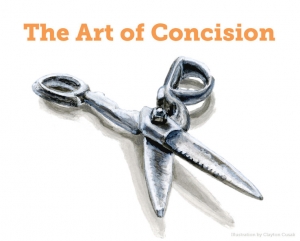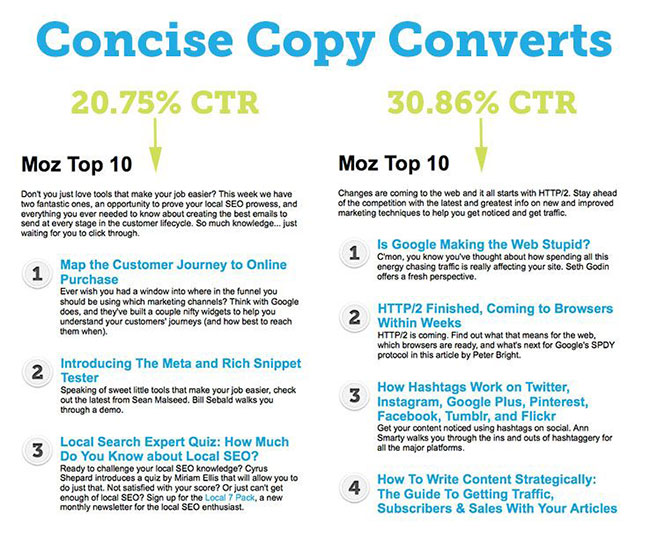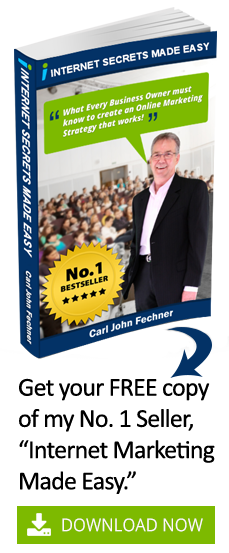 Do you know how important the art of concision is when it comes to blogging? Here’s a great article to help us improve our writing skills. With this article, we can better understand the art of concision. Thanks to Isla McKetta for creating this very informative article.
Do you know how important the art of concision is when it comes to blogging? Here’s a great article to help us improve our writing skills. With this article, we can better understand the art of concision. Thanks to Isla McKetta for creating this very informative article.
You and your readers are being bombarded with information. Too often that’s in the shape of long-winded emails, blog posts, and reports that say very little or assume that because digital space is (virtually) free and unlimited, so is your time.
But time and attention are valuable. If you learn to practice concision in all your writing (from emails and reports to blog posts, whitepapers, and product copy), you’ll not only get your point across, you might also earn your readers’ trust, gratitude, and repeat traffic. Plus, concise copy converts better.
Quick advice on writing concisely
The best advice I ever received about writing concisely came from former newspaperman (and current Moz associate) Ronell Smith. He said that in order to clearly get your point across in the fewest possible words it’s essential to:
- Write a one-sentence description of the post you wish to write (this is basically the headline)
- Think of the number one thing you’d like readers to take away from the post
- Highlight at least three facts (authoritative, supportive evidence) that support this main point
- Jot down notes that help you tell the story using these facts
- Spend a few days letting the elements “breathe”
Now if I were writing the most concise blog post ever, I’d stop right there, because Ronell already said the most important things. But sometimes it’s helpful to see how someone else puts advice into action. So here’s how I’m putting Ronell’s advice to work to write a post about concision.
Write a one-sentence description of the post
Learning how to make your point in as few words as possible will help you capture your audience’s attention.
I could (and should) stop there. But I want to make a couple of points about why this is important:
- Your brain does a lot of work as it’s trying to condense that amazing idea in your head down into one sentence—as much work as creating a whole first draft.
- Once you have a one-sentence description of where you’re going, it’s easy to toss aside all those other exciting ideas that try to plant themselves on the page and focus on what you wanted to say in the first place.
Think of the number one thing you’d like readers to take away from the post
Fewer words often makes for clearer, more impactful communication. Once I know exactly what it is that I want you to take away from this post, I can make a promise that everything will contribute to that number one goal. This is good because:
- It helps you focus on one audience. When you’re writing amazing tips on keyword research, it can be really easy to want to also remind readers why keyword research is important. That’s the moment when you lose the interest of people who get the whys of keyword research. They are now bored and done with you (even though you were just about to blow their minds with really revolutionary information).
- You know what to lead with. Even if you’re writing a crucial email, you can bet not everyone will read every word (or paragraph). By leading with the most important part, your message is more likely to be understood.
Highlight at least three facts that support this main point
Technically, I’ve been cheating so far and adding in facts along the way. This step will help you:
- Build an outline of what you want to say. It’s easier to write to outlines and you’ll be sure to include all the points you wanted to see.
- Preview the quality of your argument. If you’re writing an article about how content is king and your first fact is “because everyone says so” and the second is “readers share stuff” and you’re struggling for a third fact, go back and find a stronger argument.
- Stay on topic.
Jot down notes that help you tell the story using those three facts
Hooray! You finally get to elaborate. I’ll start my elaboration by telling you that I’ve deleted about 500 words from this post already just because I was thinking so hard about concision. Do I miss a little of my standard whimsy and storytelling style? Yes (although I’m making up for it in this paragraph).
Because you’ve already honed in tight on your subject, you can let your creative self a little loose now. Enjoy embellishing your evidence with relevant examples and case studies. Relish the chance to make your points more memorable and engage your audience by sharing pertinent stories.
Spend a few days letting the elements “breathe”
Once you’ve pulled together your main point with supporting facts and illustrated those with stories, you need to step away from your writing. If you’re writing an email, you might not have a few days, but at least go to lunch or grab a coffee. Giving your writing room to breathe allows you to:
- Spot gaps. Everything makes perfect sense in your head, but a breath of fresh air might help you see where you forgot to actually write down a crucial piece of your argument.
- See redundancies. Sometimes you’re so passionate about something you say it twice (although usually in slightly different ways). A second, later read can show you where you’re repeating yourself.
- Be rational. Speaking of passion, sometimes we write things we’d never actually want to see out in the world. Allowing your writing to rest can help you make your point without saying anything you wouldn’t want repeated. This makes you easier to listen to as well.
The rest of the story
Now that we’ve seen Ronell’s points in action, there are a few more things I want to add.
Concision usually happens in editing
If you’ve been following Ronell’s advice, your writing is going to be a lot clearer, shorter, and more impactful. But don’t count on your first draft to be the best draft. You can usually clean up a lot of extra words (and random errors) with a second draft.
Why concision?
You’re busy. Your boss is busy. Your reader is busy. We’re all reading less and less of the information presented to us. But reading is still a critical way that we share information. By learning to say more with fewer words, you’ll get your point across and come out on top.
Concision ain’t easy
In fact, you might spend more time crafting your message. Making your point makes that time and effort worth the extra work. Take the Moz Top 10 for example: over the last six editions, the ones with the fewest number of words have had the highest click-through rates.
Shortening the Moz Top 10 often takes me an extra draft, but that kind of increase in CTR is worth one more pass.
How this works at Moz
I was shocked when Trevor and I found that the most popular Moz blog posts (usually) come in at 1,200-1,800 words. That seemed long to me (especially for the Internet), but then I realized how much advice and education are usually packed into one post.
Compare that with what we sometimes see in YouMoz, which are initial drafts of 4,000-8,000 words. I am certain that a few of those authors have that much valuable information to share about one topic. But my guess is that most of those articles are trying to do too much in one post or are repeating themselves unnecessarily. I’d also be really surprised if most readers manage to reach the end of a post that long. That’s the real tragedy of overly wordy writing: No matter how brilliant you are, unless you are the most engaging writer ever, no one is reading what you’re writing. And according to one study, visitors only read 18% of content beyond the 1,250 word mark.
Do you have tips for stripping the bloat from your writing? Or do you truly love (and actually read) long-form writing on the web? Write me a novel in the comments ☺
This article was originally
published by Isla McKetta on
Moz.com
This content is syndicated news that can be used for your research, and we hope that it can help your productivity. This content is for educational purposes and is not made for any kind of commercial purposes of this blog.





